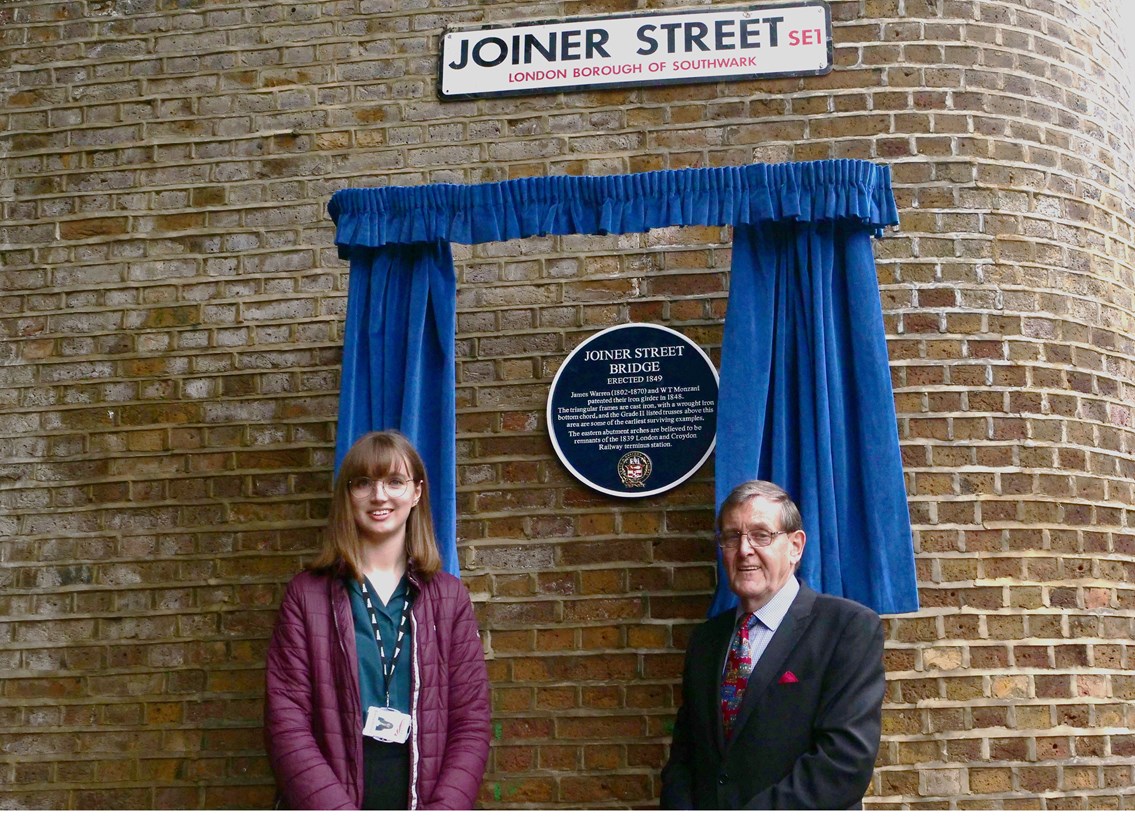Tuesday 23 Apr 2019
New heritage plaque unveiled on historic Joiner Street at London Bridge station
- Region & Route:
- Southern
The plaque, which commemorates the historic ‘Warren’ trusses at London Bridge station, has been unveiled by the Railway Heritage Trust.
People using London Bridge station can now learn a little bit more about the history of engineering at the station via a new historical plaque which marks six Warren trusses, originally built in 1849 to enable a railway viaduct to be widened
The trusses are located above the northern side of Joiner Street (close to the London Underground station). Network Rail has worked with the Railway Heritage Trust to clean up and restore the trusses as part of the Thameslink Programme’s redevelopment of London Bridge station.
Ian Hanson, stations director for Network Rail South East, said:
“We’re delighted to recognise this important piece of industrial history with a blue plaque at London Bridge. It’s fantastic that we’ve been able to preserve so much of the station’s heritage despite the huge amount of change at London Bridge over the last few years.”
Andy Savage, executive director for the Railway Heritage Trust, said:
“The RHT has been delighted to sponsor the retention and restoration of heritage features at London Bridge, with grants totalling over £650,000 during the project. The Warren Trusses are a wonderful early example of this structural form and have been a hidden feature of the station for too long. Their restoration, and the tidying up of the area around them, puts them on display in a way they never have been in the last 170 years.”
The Warren trusses at London Bridge are significant as they represent surviving examples of the development of composite iron construction in the 1840s. They take their name from the engineer James Warren (1802–1870) who took out a patent for this form of truss in 1848.
As can be seen at Joiner Street, a Warren truss consists of a series of equilateral triangles joined by top and bottom chords. The trusses are of varying lengths, from 15m to 21m, to accommodate the layout of Joiner Street at its junction with Tooley Street.
The heritage plaque is not the only change on Joiner Street recently. As part of the South East route’s station transformation plan, Joiner Street has had a makeover to improve the look and feel of the interchange area between the national rail station and the Tube station.
Brickwork has been cleaned and re-pointed, redundant service cables removed to tidy up the appearance of the area further, while a stylish brown sheathing has been added to the ceiling to complete the transformation.
Notes to Editors
About Thameslink Programme
The Government-sponsored £7bn Thameslink Programme is an ambitious 10 year programme to transform north-south travel through London. It is delivering new longer and more spacious trains running more frequently than before, through central London in the peak, improved connections to more destinations on an expanded Thameslink network including Cambridge and Peterborough and more robust tracks and modern signalling using digital railway technology to make journeys more reliable. The Programme has also completely rebuilt stations at Blackfriars and London Bridge. “
The Thameslink Programme is being delivered in partnership between the Department for Transport, Network Rail, Govia Thameslink Railway, Southeastern and Siemens. www.thameslinkprogramme.co.uk
About London Bridge Station
The Thameslink Programme has upgraded the country’s fourth busiest railway station in a £1billion transformation nearly doubling its passenger capacity and enabling more and faster connections for passengers.
In a five-year build, Costain on behalf of the Thameslink Programme, has created the largest street level station concourse in the UK for passengers to make their connections smoothly and efficiently. Work has included a major track upgrade, a new rail underpass on the approach to the station and platform widenings and extensions all of which has enabled a 30% increase in train capacity.
Originally built in 1836, London Bridge station is the oldest station in central London. It was an amalgamation of two separate stations that had been run by different rail companies. Connectivity between the two was challenging and facilities for passengers limited. Today it caters to around 48 million passengers per year, making it one of the busiest stations in the country.
The last major investment in the station was in the 1970s and it has never properly been rebuilt around passengers’ needs. London Bridge was built on hundreds of Victorian arches and viaducts, some of which had been rapidly repaired following bomb damage during the war. To create the new station concourse, many of those arches had to be demolished and replaced by a series of massive bridge decks.
Contact information
Passengers / community members
Network Rail national helpline
03457 11 41 41
Latest travel advice
Please visit National Rail Enquiries
Journalists
Tony Henderson
tony.henderson@networkrail.co.uk
About Network Rail
We own, operate and develop Britain's railway infrastructure; that's 20,000 miles of track, 30,000 bridges, tunnels and viaducts and the thousands of signals, level crossings and stations. We run 20 of the UK's largest stations while all the others, over 2,500, are run by the country's train operating companies.
Usually, there are almost five million journeys made in the UK and over 600 freight trains run on the network. People depend on Britain's railway for their daily commute, to visit friends and loved ones and to get them home safe every day. Our role is to deliver a safe and reliable railway, so we carefully manage and deliver thousands of projects every year that form part of the multi-billion pound Railway Upgrade Plan, to grow and expand the nation's railway network to respond to the tremendous growth and demand the railway has experienced - a doubling of passenger journeys over the past 20 years.
Follow us on Twitter: @networkrail
Visit our online newsroom: www.networkrailmediacentre.co.uk

